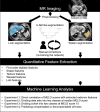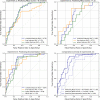MRI-based radiomic feature analysis of end-stage liver disease for severity stratification
- PMID: 33646521
- PMCID: PMC7946682
- DOI: 10.1007/s11548-020-02295-9
MRI-based radiomic feature analysis of end-stage liver disease for severity stratification
Abstract
Purpose: We aimed to develop a predictive model of disease severity for cirrhosis using MRI-derived radiomic features of the liver and spleen and compared it to the existing disease severity metrics of MELD score and clinical decompensation. The MELD score is compiled solely by blood parameters, and so far, it was not investigated if extracted image-based features have the potential to reflect severity to potentially complement the calculated score.
Methods: This was a retrospective study of eligible patients with cirrhosis ([Formula: see text]) who underwent a contrast-enhanced MR screening protocol for hepatocellular carcinoma (HCC) screening at a tertiary academic center from 2015 to 2018. Radiomic feature analyses were used to train four prediction models for assessing the patient's condition at time of scan: MELD score, MELD score [Formula: see text] 9 (median score of the cohort), MELD score [Formula: see text] 15 (the inflection between the risk and benefit of transplant), and clinical decompensation. Liver and spleen segmentations were used for feature extraction, followed by cross-validated random forest classification.
Results: Radiomic features of the liver and spleen were most predictive of clinical decompensation (AUC 0.84), which the MELD score could predict with an AUC of 0.78. Using liver or spleen features alone had slightly lower discrimination ability (AUC of 0.82 for liver and AUC of 0.78 for spleen features only), although this was not statistically significant on our cohort. When radiomic prediction models were trained to predict continuous MELD scores, there was poor correlation. When stratifying risk by splitting our cohort at the median MELD 9 or at MELD 15, our models achieved AUCs of 0.78 or 0.66, respectively.
Conclusions: We demonstrated that MRI-based radiomic features of the liver and spleen have the potential to predict the severity of liver cirrhosis, using decompensation or MELD status as imperfect surrogate measures for disease severity.
Keywords: Biomarker; Clinical decision support; End-stage liver disease; Radiomics.
Conflict of interest statement
The authors declare that they have no conflict of interest.
Figures




Similar articles
-
Quantitative Analysis of Liver Disease Using MRI-Based Radiomic Features of the Liver and Spleen.J Imaging. 2022 Oct 9;8(10):277. doi: 10.3390/jimaging8100277. J Imaging. 2022. PMID: 36286371 Free PMC article.
-
Radiomics model based on preoperative gadoxetic acid-enhanced MRI for predicting liver failure.World J Gastroenterol. 2020 Mar 21;26(11):1208-1220. doi: 10.3748/wjg.v26.i11.1208. World J Gastroenterol. 2020. PMID: 32231424 Free PMC article.
-
A radiomics-based biomarker for cytokeratin 19 status of hepatocellular carcinoma with gadoxetic acid-enhanced MRI.Eur Radiol. 2020 May;30(5):3004-3014. doi: 10.1007/s00330-019-06585-y. Epub 2020 Jan 30. Eur Radiol. 2020. PMID: 32002645
-
Doppler Ultrasound in Liver Cirrhosis: Correlation of Hepatic Artery and Portal Vein Measurements With Model for End-Stage Liver Disease Score.J Ultrasound Med. 2017 Apr;36(4):725-730. doi: 10.7863/ultra.16.03107. Epub 2016 Dec 27. J Ultrasound Med. 2017. PMID: 28026900
-
Current status of magnetic resonance imaging radiomics in hepatocellular carcinoma: A quantitative review with Radiomics Quality Score.World J Gastroenterol. 2024 Jan 28;30(4):381-417. doi: 10.3748/wjg.v30.i4.381. World J Gastroenterol. 2024. PMID: 38313230 Free PMC article. Review.
Cited by
-
Artificial Intelligence in Liver Diseases: Recent Advances.Adv Ther. 2024 Mar;41(3):967-990. doi: 10.1007/s12325-024-02781-5. Epub 2024 Jan 29. Adv Ther. 2024. PMID: 38286960 Review.
-
Systematic review and meta-analysis on the classification metrics of machine learning algorithm based radiomics in hepatocellular carcinoma diagnosis.Heliyon. 2024 Aug 14;10(16):e36313. doi: 10.1016/j.heliyon.2024.e36313. eCollection 2024 Aug 30. Heliyon. 2024. PMID: 39253167 Free PMC article.
-
Can Persistent Homology Features Capture More Intrinsic Information about Tumors from 18F-Fluorodeoxyglucose Positron Emission Tomography/Computed Tomography Images of Head and Neck Cancer Patients?Metabolites. 2022 Oct 14;12(10):972. doi: 10.3390/metabo12100972. Metabolites. 2022. PMID: 36295874 Free PMC article.
-
Radiomics Applications in Spleen Imaging: A Systematic Review and Methodological Quality Assessment.Diagnostics (Basel). 2023 Aug 8;13(16):2623. doi: 10.3390/diagnostics13162623. Diagnostics (Basel). 2023. PMID: 37627882 Free PMC article. Review.
-
Quantitative Analysis of Liver Disease Using MRI-Based Radiomic Features of the Liver and Spleen.J Imaging. 2022 Oct 9;8(10):277. doi: 10.3390/jimaging8100277. J Imaging. 2022. PMID: 36286371 Free PMC article.
References
-
- Roth CG (2016) Fundamentals of body MRI, 2nd edn. Fundamentals of radiology. Elsevier, Marrickville
-
- Organ procurement and transplantation network and united network for organ sharing. Policy note: clerical changes for implementation of adding serum sodium to the meld score. https://optn.transplant.hrsa.gov/media/1575/policynotice_20151101.pdf. Accessed 17 Feb 2021
MeSH terms
Grants and funding
LinkOut - more resources
Full Text Sources
Other Literature Sources
Medical

